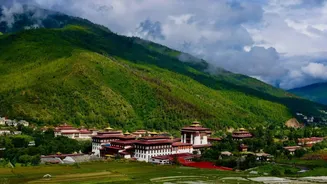When we talk about international travel, visas are usually an afterthought — a necessary step before the adventure begins. Most countries charge a standard
processing fee, depending on the destination and duration of stay. Some nations even allow visa-free access or provide quick e-visas to encourage tourism. But what if we told you that there is one country in the world where the visa itself can cost you hundreds of dollars per day? And surprisingly, it is not the United States, the United Kingdom, or any other European destinations. Located somewhere deep in the Eastern Himalayas, Bhutan has completely transformed the concept of mindful travel. Not many know but the visa model of Bhutan is built as per a Sustainable Development Fee (SDF). This is what has made Bhutan the most expensive country to visit on a daily basis. The country measures success not by GDP but by Gross National Happiness, and this philosophy also extends to how it manages tourism. Unlike most nations that charge a one-time visa or entry fee, Bhutan follows what it deems as a “High Value, Low Volume” policy. Basically, to visit Bhutan, most foreign travellers, (except citizens of India, Bangladesh, and the Maldives) must pay a Sustainable Development Fee (SDF) of $100 per person per night, and that is just the starting point. Earlier, this fee was even higher at $200 per night. However, it was reduced in 2023 to attract more visitors. This fee comes on top of the regular travel expenses, such as accommodation, meals, guides and transport. For instance, If you are planning a seven-day trip, the visa and SDF alone can easily exceed $700 per person - making Bhutan the most expensive visa destination in the world. Why Is Bhutan So Expensive? Bhutan's logic behind the hefty fee is simple: To protect what it treasures the most: its natural beauty and cultural heritage. The SDF, which is collected by tourists, goes toward sustainability initiatives, infrastructure development and environmental conservation projects. The government, in fact, ensures that tourism revenue directly benefits the local population while keeping the country’s ecological footprint minimal.
















